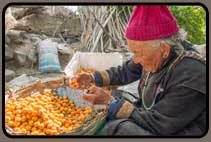|
|
|||
|
Home / About us / Treks / Tours / Homestays / Ecotourism / Contact us |
|
||
|
Homestays Many tourists come to see Ladakh, but they do not see the real Ladakh. They come through travel companies and go on pre-arranged camping treks that bring little income to the villages along the trekking routes. The agencies arrange luxuries and comforts such as chairs, tables and western food. These trekkers do not even get the chance to try Ladakhi food. Recently homestays have been started in villages in some of the trekking areas, generating income for the villagers and reducing the strain on the ecosystem caused by camping. On most of the trekking routes in Hemis National Park, trekkers can now use homestays as they trek from village to village. They can walk during the day and at night stay in traditional homes where they can eat Ladakhi food, meet local people and experience the Ladakhi culture and lifestyle. Bedding, three meals a day and safe drinking water are provided. Toilets are normally the traditional Ladakhi composting toilets, similar to long drop composting toilets in other countries, but please do not expect a western style seat! After using the toilet you should always throw a shovel of earth/cow dung down the hole to cover the waste, reduce the smell and aid composting. Most homestays do not have running water. If you want water to wash in, please ask your guide to arrange it - cold water will always be available, hot water may not. It can be difficult to find somewhere private to wash. Click here to see our recommendations on things to bring with you as well as information about altitude sickness, drinking water and cultural considerations. The homestay system was started by the Snow Leopard Conservancy, a non government organization, dedicated to preserving Ladakhi wildlife. The system was set up in order to generate income for the villagers in Hemis National Park, famous for its wildlife. In the past snow leopards used to kill many of the domestic animals, and since the people were dependent on the domestic animals, they tried to kill the snow leopard to preserve their livestock. The villagers were trained in flora and fauna, how to maintain a tourist friendly home and taught how to prepare food hygienically. 10% of the income goes to local development. In the beginning, villagers were very shy about letting tourists into their homes. However, once a woman from the village of Rumbak decided to provide a homestay, other villagers followed suit when they realised the income possibilities. Out of the nine houses in Rumbak, all are now homestays and Rumbak is a popular homestay destination. Another homestay organisation, the Youth Association For Conservation and Development in Hemis National Park, was formed by youth from all the villages in the park. This association works for conservation and sustainable development through community based approaches that benefit the villages as a whole. One of their objectives is to economically uplift people in the remote areas through ecotourism, education, handicrafts, research, improved agriculture and animal husbandry practice which is specially linked to the conservation of nature and culture. They have extended the homestay system to other villages as part of their work in ecotourism in Hemis National Park. The association also trains nature guides from the region. Women's groups have set up tea tents near villages along the trekking routes, selling tea, local breads and handicrafts, bringing extra income to the villages and directly benefiting the women. |
|||





